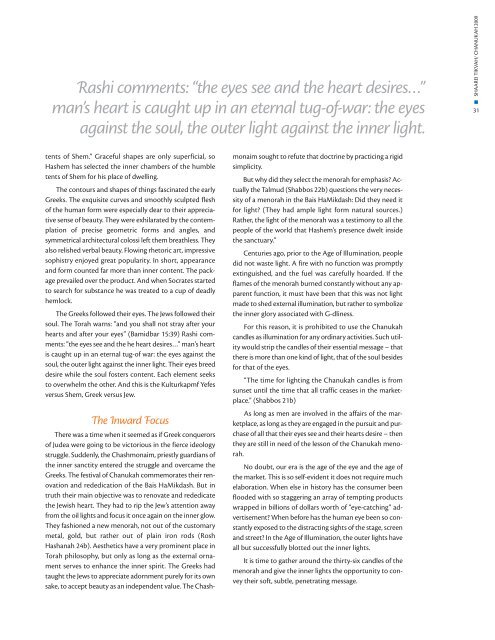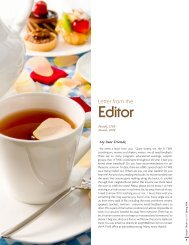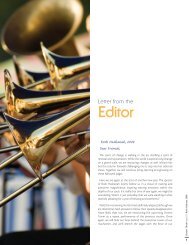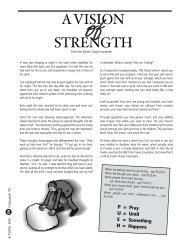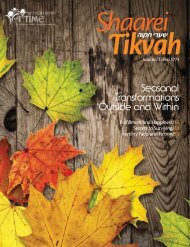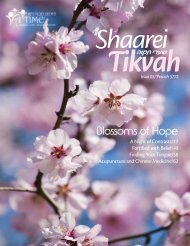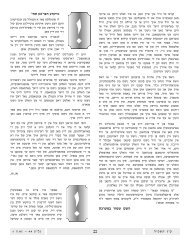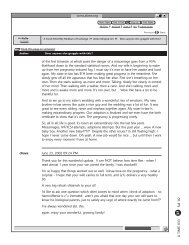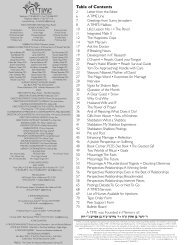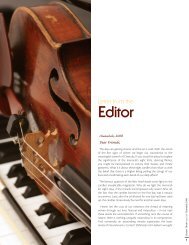Create successful ePaper yourself
Turn your PDF publications into a flip-book with our unique Google optimized e-Paper software.
Rashi comments: “the eyes see and the heart desires…”<br />
man’s heart is caught up in an eternal tug-of-war: the eyes<br />
against the soul, the outer light against the inner light.<br />
SHAAREI TIKVAH/ CHANUKAH <strong>2009</strong><br />
31<br />
tents of Shem.” Graceful shapes are only superficial, so<br />
Hashem has selected the inner chambers of the humble<br />
tents of Shem for his place of dwelling.<br />
The contours and shapes of things fascinated the early<br />
Greeks. The exquisite curves and smoothly sculpted flesh<br />
of the human form were especially dear to their appreciative<br />
sense of beauty. They were exhilarated by the contemplation<br />
of precise geometric forms and angles, and<br />
symmetrical architectural colossi left them breathless. They<br />
also relished verbal beauty. Flowing rhetoric art, impressive<br />
sophistry enjoyed great popularity. In short, appearance<br />
and form counted far more than inner content. The package<br />
prevailed over the product. And when Socrates started<br />
to search for substance he was treated to a cup of deadly<br />
hemlock.<br />
The Greeks followed their eyes. The Jews followed their<br />
soul. The Torah warns: “and you shall not stray after your<br />
hearts and after your eyes” (Bamidbar 15:39) Rashi comments:<br />
“the eyes see and the he heart desires…” man's heart<br />
is caught up in an eternal tug-of war: the eyes against the<br />
soul, the outer light against the inner light. Their eyes breed<br />
desire while the soul fosters content. Each element seeks<br />
to overwhelm the other. And this is the Kulturkapmf Yefes<br />
versus Shem, Greek versus Jew.<br />
The Inward Focus<br />
There was a time when it seemed as if Greek conquerors<br />
of Judea were going to be victorious in the fierce ideology<br />
struggle. Suddenly, the Chashmonaim, priestly guardians of<br />
the inner sanctity entered the struggle and overcame the<br />
Greeks. The festival of <strong>Chanukah</strong> commemorates their renovation<br />
and rededication of the Bais HaMikdash. But in<br />
truth their main objective was to renovate and rededicate<br />
the <strong>Jewish</strong> heart. They had to rip the Jew’s attention away<br />
from the oil lights and focus it once again on the inner glow.<br />
They fashioned a new menorah, not out of the customary<br />
metal, gold, but rather out of plain iron rods (Rosh<br />
Hashanah 24b). Aesthetics have a very prominent place in<br />
Torah philosophy, but only as long as the external ornament<br />
serves to enhance the inner spirit. The Greeks had<br />
taught the Jews to appreciate adornment purely for its own<br />
sake, to accept beauty as an independent value. The Chashmonaim<br />
sought to refute that doctrine by practicing a rigid<br />
simplicity.<br />
But why did they select the menorah for emphasis? Actually<br />
the Talmud (Shabbos 22b) questions the very necessity<br />
of a menorah in the Bais HaMikdash: Did they need it<br />
for light? (They had ample light form natural sources.)<br />
Rather, the light of the menorah was a testimony to all the<br />
people of the world that Hashem’s presence dwelt inside<br />
the sanctuary.”<br />
Centuries ago, prior to the Age of Illumination, people<br />
did not waste light. A fire with no function was promptly<br />
extinguished, and the fuel was carefully hoarded. If the<br />
flames of the menorah burned constantly without any apparent<br />
function, it must have been that this was not light<br />
made to shed external illumination, but rather to symbolize<br />
the inner glory associated with G-dliness.<br />
For this reason, it is prohibited to use the <strong>Chanukah</strong><br />
candles as illumination for any ordinary activities. Such utility<br />
would strip the candles of their essential message – that<br />
there is more than one kind of light, that of the soul besides<br />
for that of the eyes.<br />
“The time for lighting the <strong>Chanukah</strong> candles is from<br />
sunset until the time that all traffic ceases in the marketplace.”<br />
(Shabbos 21b)<br />
As long as men are involved in the affairs of the marketplace,<br />
as long as they are engaged in the pursuit and purchase<br />
of all that their eyes see and their hearts desire – then<br />
they are still in need of the lesson of the <strong>Chanukah</strong> menorah.<br />
No doubt, our era is the age of the eye and the age of<br />
the market. This is so self-evident it does not require much<br />
elaboration. When else in history has the consumer been<br />
flooded with so staggering an array of tempting products<br />
wrapped in billions of dollars worth of “eye-catching” advertisement?<br />
When before has the human eye been so constantly<br />
exposed to the distracting sights of the stage, screen<br />
and street? In the Age of Illumination, the outer lights have<br />
all but successfully blotted out the inner lights.<br />
It is time to gather around the thirty-six candles of the<br />
menorah and give the inner lights the opportunity to convey<br />
their soft, subtle, penetrating message.


